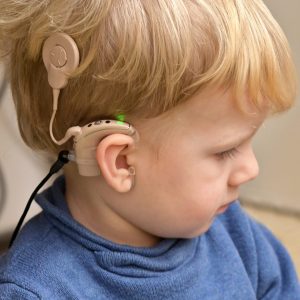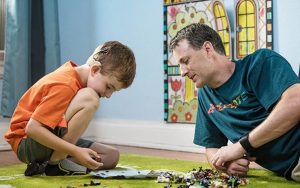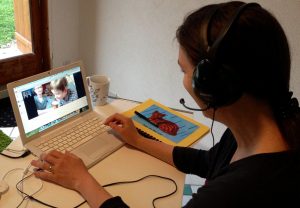
Auditory Verbal Therapy for Cochlear Implant kids
Auditory Verbal Therapy for Cochlear Implant kids
Auditory verbal therapy, Human communication is multi-sensory- involving visual, tactile, and auditory cues. The sense of hearing offers us a powerful means of communication. Hearing connects and enables us to experience all the little things around us through sound. It enables us to socialize, work and communicate. Hearing empowers us and helps us lead our everyday lives without limitations. It allows collecting, processing and interpretation of sounds uninterruptedly and without conscious effort; so, we may take this distinct sense of communication for granted.

Hearing loss and intervention
According to World Health Organization or WHO (2020), a person who is not able to hear as well as someone with normal hearing – hearing thresholds of 25 dB or better in both ears – is said to have hearing loss. Hearing loss may be mild, moderate, severe, or profound. ‘Hard of hearing’ refers to people with hearing loss ranging from mild to severe. It can affect one ear or both ears, and causes difficulty in hearing conversational speech or loud sounds.
As the renowned educator and activist of 20th-century, Helen Keller, once said, “Blindness cuts us off from things, but deafness cuts us off from people”. More than 5% of the world’s population or 466 million people has disabling hearing loss (34 million children and 432 million adults).
Hearing loss results in delayed language-learning process in children. Hence, detecting and intervening early is crucial for children with hearing loss to minimize its impact on speech and language development.
In cases where hearing loss is unavoidable, it is vital to ensure access to appropriate assistive technologies such as hearing aids and cochlear implants, and communication services like speech therapy, sign language and captioning (WHO, 2018). A cochlear implant is an established, effective and long- term solution for people with moderate to profound hearing loss. The cochlear implant artificially stimulates the inner ear with electrical signals, which sends those signals to the auditory nerve, letting a person hear.
Listening through cochlear implant
Listening through cochlear implant allows the child to hear sounds. Nevertheless, this sound is different from natural hearing. Hence,in order to get the best result out of your child’s cochlear implant, it is important to practice listening through auditory training.
It aims at improving listening, speech and language skills through play and active involvement in everyday situations. Ultimately, hearing and active listening become a vital part of child’s communication, academics, socialization and work.
Frequently Asked Questions
How is AVT different from other kinds of therapy?
There are multiple training strategies improve communication skills of children with hearing impairment. American Sign Language, cued speech and total communication are some examples. AVT follows the below mentioned principles:
- Early identification of hearing impairment
- Prompt audiological management – fit adequate listening device (hearing aids, cochlear implants, etc.)
- Provide guidelines, counselling, and support to parents and caregivers; and empower them as the primary models for speech and language development
- Assist children to integrate listening into their overall progress of communication and social skills.
- To support children’s auditory-verbal development through one-on-one training
- Train children to enhance the intelligibility of their speech by monitoring their own voices and the voices of others
- Practice the developmental patterns of listening, language, speech, and cognition in order to stimulate natural communication
- To serially assess and evaluate children’s progress and, modify the program as per need
- Provide support services to facilitate children’s educational and social inclusion
Who provides AVT?
AVT is provided by a certified auditory-verbal therapist who is a mentor, psychologist, audiologist, or speech-language pathologist. The therapy is provided in a clinic set up as well as in a tele-rehabilitation set up. In school set up the critical role of the Auditory-Verbal therapist is to provide support services for teachers to meet the academic needs of each child.
What are the stages of AVT?
The stages of listening in AVT are outlined below:
-
Sound awareness- the first step in learning to listen
In this stage, the child starts to detect sounds around her. He/ she responds to voice of the caretaker or to loud sounds in the environment. Different behaviors of the child which are important to determine whether he/ she is able to detect sounds. This skill is the groundwork of the learning to listen process.
-
Associating Meaning to Sound
In this stage the child begins to associate a sound with its related item(example, /a/ for airplane) and begins to recognize familiar phrases.
-
Imitation and Expansion
She continues to imitate even after she has started to produce words and phrases spontaneously.
-
Auditory Comprehension
This stage involves long- and short-term memory, complex auditory skills such as sequencing and auditory association. Auditory comprehension is the pre-requisite for effective communication through spoken language.
-
Advanced Listening Skills
This involves listening from a distance, listening in the presence of background noise, and executing conversation on the telephone.
Can Auditory-Verbal training be used in combination with other training strategies?
The Auditory-Verbal approach involves a set of principles aiming at the maximum use of hearing for learning. It does not implement formal visual communication systems like sign language and cued speech.
What age is appropriate to commence AVT?
AVT should be commenced as soon as the infant has been fitted with cochlear implant. No infant is too young to go ahead with the training sessions. Since the human brain absorbs information most quickly in infancy, this stage should be enriched by starting therapy and parent training.
What outcomes can be achieved by using AVT?
The outcomes of AVT vary with factors like, age of the child, contribution of the family, occurrence of multiple disorders, availability of professional services, type of academic programs, and other factors. The goal of AVT is to maximize the child’s use of hearing. Each child responds to this differently. However, the amount of therapy the child receives is equally important to the amount of time the parents spend engaging their child in listening activities as well as speech and language stimulation.
How does AVT through tele-therapy carried out in case of children with cochlear implant?
AVT is all about enriching parents or caregivers with the skills and approaches to support their child’s listening, speech and language development. Tele-therapists aim at:
- Ensuring that the parents are equipped with the knowledge to support their child in their everyday lives, regardless of physical location
- Setting goals involving the parent ahead of the session, plan what online resources, toys or routines at home will be used during the session
- providing realistic and practical home training programs
- training the parents to appropriately carry out the speech and language simulation at home.
Auditory verbal therapy
 Thus, tele-therapy is much more straightforward, as the main service user is the parent. The need to be physically present in the same room is significantly reduced as parents can still be trained by their AV tele-therapist
Thus, tele-therapy is much more straightforward, as the main service user is the parent. The need to be physically present in the same room is significantly reduced as parents can still be trained by their AV tele-therapist
On the whole,
It promotes early intervention and management of hearing loss through audiological technologies. AVT ensures that the parents become the primary facilitators of their child’s speech and language development. Eventually, parents and caregivers attain confidence that their child can have access to an entire range of social, academic and occupational options.
Image Credits:
Auditory verbal therapy
- Paper Cups for Language Development - March 15, 2022
- ADIP Scheme for Hearing Impairment - August 4, 2021
- Auditory Verbal Therapy for Cochlear Implant kids - December 30, 2020


Leave a Comment
(0 Comments)